Abstract
At present, the surface quality of Yuba skin is determined by sensory methods. In order to realize the intelligent classification detection of Yuba skin quality, this study designed a system that automatically determines the quality of Yuba skin surfaces based on image processing and support vector machine (SVM) approaches. Specifically, the system uses image preprocessing to extract the grayscale eigenvalues, gray level co-occurrence matrix (GLCM) eigenvalues, and gray level run length matrix (GLRLM) eigenvalues of the sample image and uses them as input values for a quality grading system. Through model evaluation of three classification models, the SVM classification model was selected according to the evaluation results, and different kernel functions were used in the model for sample training. Based on Matlab, the quality grading software of Yuba skin was developed and designed. Intelligent detection and grading were realized through the radial basis kernel function support vector machine (RBF-SVM) grading model. The best penalty factor (c = 3.50) and kernel parameter value (g = 0.98) were obtained through cross-validation. The accuracy of the model was 95.31% and 94.16% for the training and test sets, respectively. The grading accuracy of the RBF-SVM grading system was 93.56%, and the error was less than 5% compared with the traditional sensory method of grading; thus, the quality classification method based on the SVM classification system for Yuba skin is feasible and can be used for quality detection.
1. Introduction
Yuba skin, a common nonfermented soybean product, is a film formed on the surface of boiled soybean milk maintained at a constant temperature [1,2]. Yuba skin has a fine texture and contains protein, oil, carbohydrates, zinc, magnesium, iron, calcium, and other nutrients; it is highly sought after because it is nutritious, tasty, and easy to digest (digestibility rate: 93%). Many studies have evaluated the correlations between soybean variety, slurry concentration during processing, heating temperature and method, and the perceptible quality of Yuba skin [3]. Nonetheless, few studies have formulated automated detection methods for judging Yuba skin quality [4]. Determinations of Yuba skin quality are based on the color of undried Yuba skin. Thus, machine vision can be used to obtain assessments of Yuba skin quality based on its color and shape [5]. The principal component analysis for Yuka skin involves several factors and is conducted according to the “DB 52/519-2007 Yuba Quality Standard”. The results indicate that the surface color of Yuba skin reflects its freshness and contributes the most to its surface quality.
In recent years, researchers have analyzed the acoustic properties [6,7], optical properties [8,9], and acoustic vibration [10,11] for nondestructive testing. With the development of machine vision technology [12,13,14,15], extensive research has been con-ducted on sorting operations for numerous agricultural products. Su et al. analyzed the appearance and size characteristics of potatoes using a convolutional neural network. Non-destructive grading of potatoes was achieved [16]. Tian et al. analyzed the image features of apples using the YOLOv3 model. Non-destructive grading of apples was achieved [17]. Liu et al. analyzed the color characteristics of tomatoes with different ripeness using a color HSV model. Nondestructive grading of tomatoes was achieved [18]. Kumar et al. analyzed the color, shape, and texture features of tomatoes using an SVM model. Non-destructive grading of tomatoes was achieved [19]. Olaniyi et al. analyzed the GLCM texture features of bananas using a neural network model. Non-destructive grading of bananas was achieved [20]. Huang et al. analyzed the image features of spinach samples using a BPNN model with multisensory data fusion. Non-destructive grading of spinach was achieved [21]. At present, the quality inspection of Yuba skin relies on human experience to determine the color and texture characteristics of the Yuba skin surface through human eyes, and then grade the Yuba skin, which is not accurate and cannot achieve intelligent grading of the Yuba skin quality. Thus, machine vision holds promise as an objective and nondestructive means for improving Yuba skin testing and accuracy, thereby adding value.
This study formulated an image processing method for automated Yuba skin quality assessment. The Yuba image is captured at the terminal of the conjunctival trough, and the image is preprocessed [22]. The average gray value is used to extract the eigenvalues of the degree of darkness on the surface of the Yuba skin, and the grayscale run length matrix (GLRLM) and the gray-level co-occurrence matrix (GLCM) are used to extract the surface texture eigenvalues of the conjunctival terminal Yuba skin. Finally, the nine extracted eigenvalue factors are used as the support vector machine (SVM) input values and Yuba skin quality is output as a classification result [23,24]. Thus, the SVM quality classification training model was established to detect the quality of the Yuba skin.
2. Materials and Methods
2.1. Sensory Classification Experiment Design
The test material was made from Heilongjiang Hairui No. 2 soybean. Through the analysis of the bean curd quality questionnaire produced by different soybeans, it can be seen that the quality of the bean curd skin produced from Heilongjiang Hairui No. 2 soybean meets the requirements of this test. The surface quality of Yuba skin has an important influence on human appetite. According to the “DB 52/519-2007 Yuba Quality Standard”, a principal component analysis was conducted on several influencing factors, and the results showed that the surface color of Yuba skin had the highest contribution to the surface quality of Yuba skin. The color of Yuba skin is a general term for color and luster, which is a mixture of the color of light (light not absorbed and transmitted by the food) reflected by the Yuba skin when it is illuminated by light. The color and luster of the Yuba skin can reflect the freshness of the Yuba skin. For soybean products, the formulation and the conjugation process of Yuba skin can affect the color of the surface. A suitable processing process can make the Yuba skin neatly shaped, light yellow in color, uniform and consistent in color, and fine in texture, without short strips and broken pieces. The traditional method of judging the shade of the surface of the Yuba skin is to rely on the human eyes to qualitatively discriminate, such as dark color, light color, etc., but the qualitative analysis of similar colors is generally difficult to distinguish or the results of the judgment will vary from person to person. Based on the national standard for the quality of Yuba skin in this paper, a color sensory scale was developed to provide a judgment basis for the subsequent sensory method, and color scoring was performed by six reviewers on five groups of test samples through the sensory method.
2.1.1. Design of Scoring Criteria
The scores for each grade are shown in Table 1. The region of interest (ROI) selection of the sample images was performed before the quality grading, and the sensory scoring table of the Yuba skin was developed based on the criteria.

Table 1.
Criteria for sensory grading of Yuba skin.
2.1.2. Sensory Method Grading Test
Five concentrations of bean slurry (6.5%, 7%, 7.5%, 8%, and 8.5%) were used to carry out the Yuba skin production test. Each concentration of Yuba skin was collected at the end of the production line, and a total of 5 groups of test samples were collected. The collected Yuba skin was stored in a drying oven and labeled. In this evaluation experiment, six evaluation experts were selected, aged 20–30, including three males and three females, all of whom were in good health and had normal vision. Relevant evaluation training was provided to the reviewers before the evaluation to ensure accurate evaluation results. The test site was a room with normal light, and the six judges scored the color of the five groups of test samples, and the subjective evaluation value of the color of the fermented soybean peel was obtained; the results are shown in Table 2. As can be seen from Table 2, the surface color scores of the five groups of Yuba skin samples at different concentrations ranged from 6.28 to 9.05, and the Yuba skin sample with the highest color score was group 5. When the original image of the sample was visually inspected, the color change of the Yuba skin sample corresponds to different slurry concentrations, which represents that an increase in the pre-pulp concentration which can moderately deepen the Yuba skin color.

Table 2.
Sensory evaluation from six experts.
The process of sensory scoring at different concentrations is shown in Figure 1, and the color score of the Yuba skin samples showed an increasing trend with the increase in concentration. This is because, as the slurry concentration increases, the protein content increases, and the color of the Yuba skin also deepens. However, when the concentration increases to a certain value, with the evaporation of the water on the surface of the slurry, the slurry is further concentrated, the protein content increases significantly, and the color of the Yuba skin becomes light yellow and shiny, which improves the color score. It can also be observed through the raw images that the compounds formed by the increased concentration of the slurry cause a visible color change in the Yuba skin, and this color change in the Yuba skin samples can be considered as a suitable method to estimate the surface color of the Yuba skin through image processing.
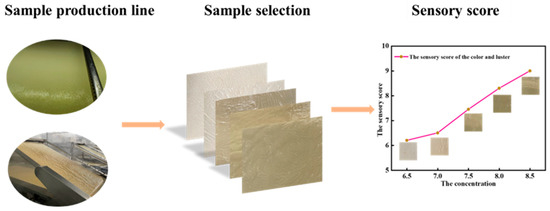
Figure 1.
Sensory scoring processes at different concentrations.
2.2. RBF-SVM Intelligent Grading System Design
In the processing of the conjunctiva of Yuba skin, different grades of Yuba skin have some differences in texture and morphology. Therefore, the texture features on the surface of Yuba skin can be extracted to distinguish the surface image features of Yuba skin and use them to design an intelligent grading system for Yuba skin.
2.2.1. System Solution Design
The specific process of the grading system is shown in Figure 2. Firstly, the ROI region extraction and pre-processing are performed on the fermented skin images captured by the industrial camera. The gray histogram distribution of sample images are analyzed through MATLAB, and histogram equalization was carried out to reduce errors. The grayscale eigenvalues, gray level co-occurrence matrix (GLCM) eigenvalues, and gray level run length matrix (GLRLM) eigenvalues of the equalized image are extracted. The gray characteristic value contains only one factor of the degree of darkness (DOD). GLCM contains four factors of Angular Second Moment (ASM), Contrast (CON), Correlation (COR), and Inverse Different Moment (IDM). GLRLM contains four factors of Short Run Emphasis (SRE), Long Run Emphasis (LRE), Gray Level Different Uniformity (GLD), and Run Length Different Uniformity (RLD). The SVM quality detection model was established based on the data of the three groups of characteristic values, and the 9 factors with different combination methods are detected by the model. To select the appropriate kernel function, we used different kernel functions to test the quality detection model and conduct a comparative analysis of the test results. Additionally, we determined the optimal quality grading model by comparing and analyzing the evaluation results and grading accuracy of 3 different grading models. After the design of the grading system was completed, a quality grading test was carried out to verify the rationality of the grading system.

Figure 2.
Software design flow chart.
2.2.2. Image Pre-Processing and Feature Value Extraction
The initial acquisition of the terminal Yuba skin conjunctiva image is completed by the image acquisition system, and then the target extraction of the region of interest (ROI) in the original image is performed, and the unwanted information in the image is eliminated by noise reduction pre-processing. Finally, the image is converted into a clear black-and-white effect image, which in turn provides the necessary basis for the extraction of multi-texture feature values in the next step. Through comparison, a Gaussian filter and Sobel operator edge detection were finally selected to achieve noise reduction of the image, and a clear black-and-white effect map is obtained by segmentation of the Big Law method in binarization. The results after pre-processing are shown in Figure 3.
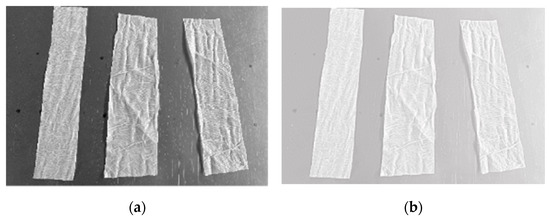

Figure 3.
Image preprocessing. (a) Original image; (b) Gaussian filter graph; (c) Sobel edge detection; (d) Big Law division.
The factors affecting the quality score of Yuba skin mainly include the processing equipment and technological process. In the technological process, if the concentration of slurry increases, the protein content becomes higher, and the color of Yuba skin deepens which the main reasons for the quality change. Therefore, we need to further explore the average gray level to determine whether there is a certain correlation between the value and the quality of Yuba skin. The quality scores of Yuba skin samples produced at different concentrations were determined by the sensory method, and the average gray value of the surface of Yuba skin samples at different concentrations was determined by the image processing method. When the image is an 8-bit pixel image, the brightest pixel has a value of 255 (white), the darkest pixel has a value of 0 (black), and the other pixels have different grayscale intensity values between 0 and 255. According to this, the average gray intensity value was normalized using Equation (1), and the obtained normalized value was defined as the degree of darkness (DOD) of the Yuba skin. The three groups of image processing results (prediction data) and sensory scoring results (experimental data) were linearly fitted, as shown in Figure 4a. The data fitting results show that there is a strong relationship between the average gray value and the quality of the Yuba skin. Correlation (R2 of the three groups are 0.99453, 0.99247, 0.99077, respectively), therefore, of the grayscale eigenvalues can be used as an alternative method for the quality score of the Yuba skin.
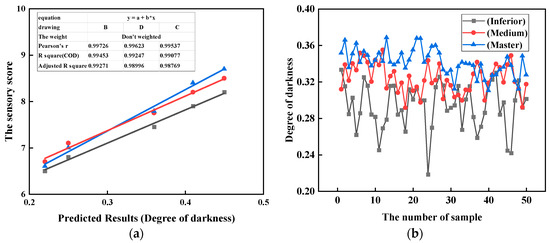
Figure 4.
Comparison of sensory scores with image processing data fitting and DOD values. (a) Sensory scores fit to image processing data; (b) DOD numerical comparison.
Master, medium, and inferior Yuba skin sample images were randomly selected, with 50 for each grade. First, the gray histogram distribution of the Yuba skin sample image was analyzed by MATLAB, the histogram equalization is carried out, and then the gray characteristic value was extracted from the image after the equalization. The results shown in Figure 4b show that the grayscale darkness value of the superior and medium Yuba skins changed relatively smoothly, and their distribution were concentrated in the ranges of 0.34–0.38 and 0.29–0.33, respectively. There is still quite a difference between these two grades of Yuba skin and the dark degree value range of the inferior Yuba skin which was mainly concentrated in the range of 0.22–0.31. Therefore, the average gray characteristic value is suitable to be used as the quality classification standard for Yuba skin.
The greycomatrix function in MATLAB was used to generate the GLCM and calculate the required parameters. A total of 150 samples were randomly selected at the terminal of the yuba skin and conjunctiva. The GLCM was obtained by calling the “Gray-Comatrix” function, and then GLCM characteristic values were extracted. The characteristic value factors were calculated, including angular second moment (ASM), contrast (CON), Correlation (COR), and inverse different moment (IDM). According to the analysis of the GLCM characteristic results, the GLCM characteristic values of the three different grades of Yuba skin have obvious differences; therefore, the GLCM characteristic values are suitable for the quality detection standard of Yuba skin. The GLCM eigenvalues are shown in Figure 5.
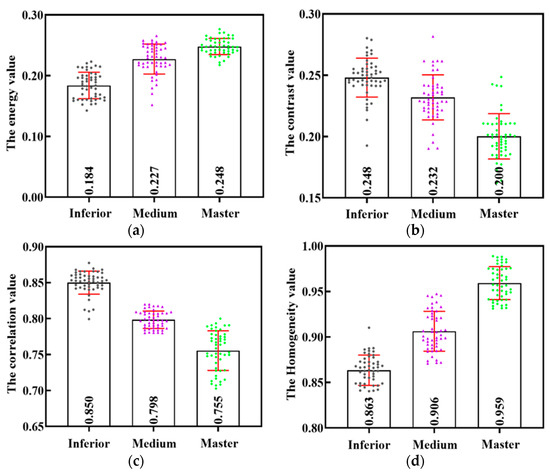
Figure 5.
GLCM eigenvalue comparisons. (a) ASM numerical comparison; (b) CON numerical comparison; (c) COR numerical comparison; (d) IDM numerical comparison. In the figure, black represents inferior Yuba skin, red represents medium Yuba skin, green represents master Yuba skin.
The getGraylevelRumatrix function in MATLAB was used to obtain the GLRLM and calculate the parameters to be collected. The same 150 Yuba skin samples were selected, the images were subjected to grayscale processing and quantification, and the GLRLM eigenvalues were extracted. The chosen parameter directions were 0° and 45°. We calculated the eigenvalues of the GLRLM, and the mean values of the data were collected from the two angles. The GLRLM eigenvalues of SRE, LRE, GLD and, RLD were calculated. Finally, the mean values of the data collected from the two angles were calculated. The comparative analysis of the GLRLM eigenvalue parameters indicated notable differences in the eigenvalues of SRE, GLD, LRE, and RLD among the three different grades of Yuba skin. Our results suggest that the mean value of GLRLM eigenvalue is suitable as a classification standard for Yuba skin quality. The GLRLM eigenvalue results are shown in Figure 6.
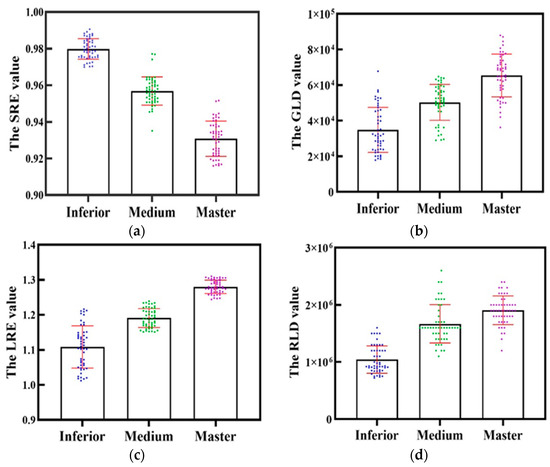
Figure 6.
GLRLM eigenvalue comparisons. (a) SRE numerical comparison; (b) GLD numerical comparison; (c) LRE numerical comparison; (d) RLD numerical comparison. In the figure, blue represents inferior Yuba skin, green represents medium Yuba skin, red represents master Yuba skin.
2.2.3. RBF-SVM Hierarchical Model Construction
SVM is a binary classification model that uses a linear classifier and determines the largest interval defined on the feature space [25]. This largest interval function distinguishes it from a perceptron. SVM contains different kernel functions, which can effectively solve linear or nonlinear classification and prediction problems. We set the Yuba skin quality classification training sample to the following:
The following is the hyperplane equation of the SVM classifier:
where:
- —Training vectors;
- —normal vector;
- —Offset of the hyperplane.
Because the quality of Yuba is indicated by one of three grades, a three-classifier module was used. When the system automatically carries out the quality classification test of Yuba skin, it first loads the sample set for treatment classification, and obtains the optimal value of the penalty factor c and kernel parameter g using the characteristic parameters of the sample set. The training and learning module in the system carries out repeated training and learning through the treatment of the test sample set, and can finally automatically form a quality grade classifier model. The test module in the system carries out grade classification through the treatment of the test sample set. When the kernel function of the classification model is the radial basis function kernel (RBF) or the polynomial kernel function, the features of GLCM and GLRLM perform better than those of other kernel functions. Overall, when the kernel function of the classification model was the RBF radial basis kernel function, the model was the most accurate on the training and testing sets than when the other kernel functions were used. When the feature category was TOTAL, the accuracy rates for the model on the training and testing sets were 95.31% and 94.16%, respectively, and the optimal parameters of the model were c = 3.50 and g = 0.98. Additionally, the robustness of the SVM classification model was the best under these conditions.
2.2.4. Establishment and Analysis of Three Classification Model Evaluation Criteria
To verify the performance of the RBF-SVM algorithm proposed in this paper, two classification algorithms, the GBDT algorithm and BP neural network (Back Propagation), were used to compare with the RBF-SVM algorithm. The maximum error (Max error), mean absolute error (MAE), mean absolute percentage error (MAPE), root mean square error (RMSE), and coefficient of determination (R2) of the model were calculated. The maximum error describes the extreme case of the prediction result, and the mean absolute error and the average absolute percentage error are based on the absolute error, which can be used together to describe the model’s prediction of the limit value, and the root mean square error and coefficient of determination describe the overall regression of the model. The results of the evaluation indicators are shown in Table 3.

Table 3.
Comparison of three models’ regression evaluation index data.
The comparison diagram and absolute percentage absolute errors of the prediction results of the SVM, BPNN, and GBDT quality prediction models are shown in Figure 7. The bias of the BPNN prediction was large, all its regression indicators were the worst, and its comprehensive prediction accuracy was the lowest. The prediction deviations of GBDT and SVM were similar, and the average absolute error and average absolute percentage error indicators were also relatively close; however, the maximum error, root mean square error, and coefficient of determination index were different, with the GBDT model having extreme errors. The subjective evaluation results of humans are linear, and the use of non-sexual models can cause bias during the training process of the sample, resulting in a decrease in the stability of the accuracy of the prediction results.
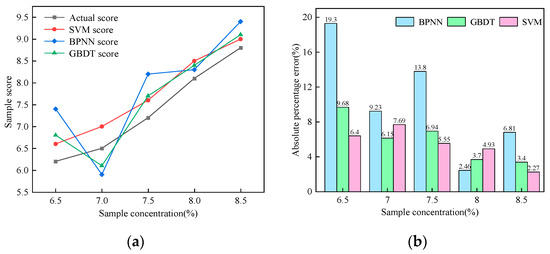
Figure 7.
Comparison of prediction results and absolute percentage errors of three models. (a) Model prediction comparison; (b) comparison of model prediction errors.
3. Results and Analysis
3.1. Quality Grading Software Interface
SVM-based software for grading the quality of Yuba skin was developed using a graphical user interface library in MATLAB. The grading software interface consisted of a preprocessing image module, feature value extraction module, and quality result module (which has a final kernel function). The software preprocesses and displays the image of the Yuba skin to be evaluated. The corresponding eigenvalue in the feature value extraction module is then calculated, and the user clicks the RBF-SVM grading button in the final quality result module to display the corresponding quality grading results. The software interface is presented in Figure 8.
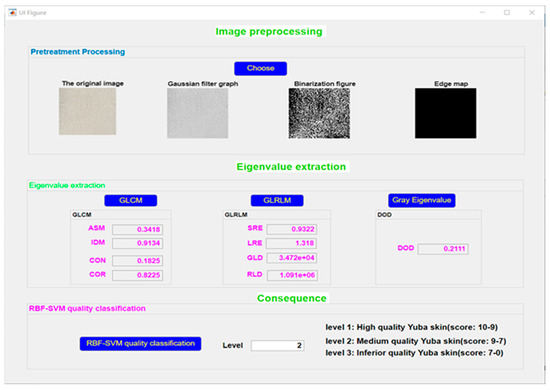
Figure 8.
Yuba quality grading software interface.
3.2. RBF-SVM Intelligent Grading Test Analysis
The software was run on a test platform (Figure 9). The platform positions the charge-coupled device (CCD) industrial camera to a position where the best pictures can be taken, and the light emissivity controller is used to set the brightness of the light source. When a stable brightness is reached, the image is captured, and the photos are uploaded to the host computer through a USB connection. After opening the Yuba skin quality classification software, the Yuba skin images that need to be classified are automatically selected by clicking the image selection button, and the images are preprocessed and displayed. Then, in the feature value extraction module, the corresponding feature values are displayed in the software by clicking the corresponding button. Finally, the corresponding results of the quality classification can be attained by clicking the RBF-SVM classification button in the final quality result module.
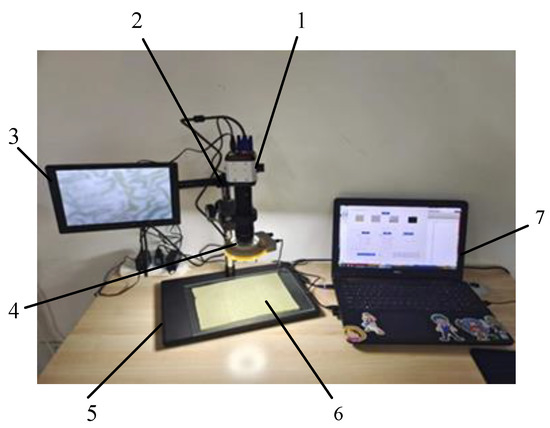
Figure 9.
Quality grading system test platform. (1) CCD; (2) Z stage; (3) LCD; (4) LED light source; (5) plane light source; (6) Yuba skin; (7) portable computer.
The collected multi-eigenvalue factors were input into the pre-established SVM grading model as input values, and the SVM grading models with different kernel functions were used to determine Yuba skin quality. Different grading results were obtained with different sum function models, and the specific grading test results are shown in Table 4.

Table 4.
Test results of different SVM kernel functions.
The test results indicate that the SVM grading system’s accuracy increased gradually with longer combinations of eigenvalues. The RBF radial basis kernel function had a 93.56% accuracy rate for the eigenvalue combination of ASM+CON+COR+IDM+SRE+LRE+GLD+RLD+DOD. Despite this promising result, further improvements can be made, possibly with a larger or more varied image dataset for training.
3.3. Sensory Method and RBF-SVM Grading Systematic Error Analysis
Two methods were used to score the Yuba skins with different concentrations, and 10 groups of Yuba skin samples were produced using the same concentration, and the scoring results were shown in Figure 10. Both methods showed that, in the concentration range of 6.5% to 8.5%, the score of the Yuba skin gradually increased with the increase in concentration. Moreover, the average score difference obtained by the two methods was small, which verifies that the results of the RBF-SVM grading system are in good agreement with the results of the actual sensory method. The average score data of each concentration using the two methods were calculated and analyzed, and the relative error results of the actual sensory method score value and the RBF-SVM grading system score value are shown in Figure 11. As shown in Figure 11, the relative error of the two methods reached a maximum of 3.31% when the concentration was 8.0%, and the minimum error of the two methods was 0.06% when the concentration was 7.0%. The relative error of the different concentration test groups was within 5%, and the test results were in line with expectations, which further proves the applicability of the RBF-SVM grading system in the quality detection of Yuba skin.
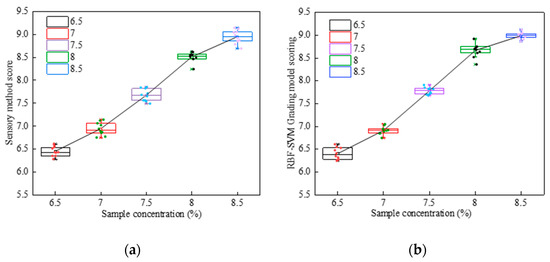
Figure 10.
Comparison of sensory method and RBF-SVM grading system scores. (a) Sensory method scores; (b) RBF-SVM grading system scores.
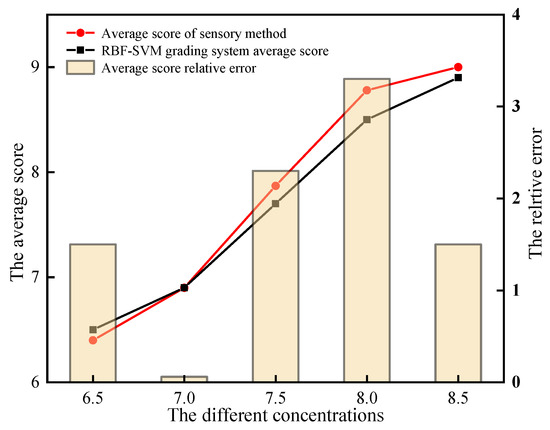
Figure 11.
Average score relative errors of sensory method and RBF-SVM grading system.
4. Discussion
In this study, an RBF-SVM classification system was designed based on image processing. The initial image is preprocessed, and then the required eigenvalues are extracted. Finally, the data of each eigenvalue are processed, and the quality grade of Yuba skin is obtained by RBF-SVM classification recognition system. However, only 150 sample images were collected for training in the establishment of the RBF-SVM model. On this basis, the number of sample images can be further increased to improve the accuracy of the RBF-SVM model.
At present, there are few studies in the field of quality classification of Yuba skin. In this paper, industrial cameras were used to shoot images of bean curd skin. In the actual test process, the accuracy of the characteristic values extracted from Yuba skin images may be affected due to changes in lighting conditions, thus affecting the accuracy of the classification. Therefore, in future research, we can carry out detailed research on image feature extraction of Yuba skin and design a classification system with a higher accuracy.
5. Conclusions
Our study collected 150 sample images to train and construct an SVM hierarchical model that evaluates Yuba skin quality. Different kernel functions were used in the model for sample training. The best penalty factor (c = 3.50) and kernel parameter value (g = 0.98) were obtained through cross-validation. The accuracy of the model was 95.31% and 94.16% for the training and test sets, respectively.
In this study, a quality grading software of Yuba skin based on the SVM model was designed. By preprocessing the initial image, then extracting the required eigenvalues, and finally processing the data of each eigenvalue, the quality of Yuba skin can be obtained through the SVM classification and recognition system. In terms of quality level, the accuracy rate reached 93.56%.
The traditional sensory method and RBF-SVM grading system were used to grade samples of Yuba skin made from different concentrations of bean curd slurry. The results show that the sensory method has good consistency with the results of the RBF-SVM grading system, and the detection error of the RBF-SVM grading system was less than 5%, which can meet the needs of automated production of Yuba skin.
Author Contributions
Conceptualization, Y.T. and L.X.; methodology, Y.T. and L.X.; software, Y.T. and Y.S,; valida-tion, Y.T., L.X. and Q.T.; formal analysis, Y.T.; investigation, H.Y. and Y.S.; resources, L.X.; data curation, Y.T. and L.X; writing—original draft preparation, Y.T.; writing—review and editing, Y.T., Q.T. and L.X.; visualization, Y.T.; supervision, L.X.; project administration, L.X. and Q.T. All authors have read and agreed to the published version of the manuscript.
Funding
This research was supported by Anhui Province Key Research and Development Program Project (grant NO. 202204c06020057).
Institutional Review Board Statement
Not applicable.
Informed Consent Statement
Not applicable.
Data Availability Statement
Not applicable.
Acknowledgments
The financial support by Anhui Province Key Research and Development Program Project is gratefully acknowledged.
Conflicts of Interest
The authors declare no conflict of interest.
References
- Su, J.-F.; Huang, Z.; Yuan, X.-Y.; Wang, X.-Y.; Li, M. Structure and properties of carboxymethyl cellulose/soy protein isolate blend edible films crosslinked by Maillard reactions. Carbohydr. Polym. 2010, 79, 145–153. [Google Scholar] [CrossRef]
- Li, S.; Liu, X.; Zhang, Y. Development of SFZCX125 automatic forming machine for curd bamboo. Grain Oil Process. 2006, 12, 72–74. (In Chinese) [Google Scholar]
- Zhang, J.; Peng, X.; Guo, S. Protein-lipid film (fuzhu) prepared from soymilk: Effects of soymilk convection on its formation, composition, and quality. LWT-Food Sci. Technol. 2021, 141, 110909. [Google Scholar] [CrossRef]
- Zhang, S.; Lee, J.; Kim, Y. Chemical composition, water vapor permeability, and mechanical properties of yuba film influenced by soymilk depth and concentration. J. Sci. Food Agric. 2018, 98, 1751–1756. [Google Scholar] [CrossRef] [PubMed]
- Zhao, T. Development and application of machine vision technology in food inspection. Food Res. Dev. 2021, 42, 233–234. (In Chinese) [Google Scholar]
- Qin, J.; Liu, X.; Van Den Abeele, K.; Cui, G. The study of wood knots using acoustic nondestructive testing methods. Ultrasonics 2018, 88, 43–50. [Google Scholar] [CrossRef]
- Donskoy, D.; Liu, D. Vibro-acoustic modulation baseline-free non-destructive testing. J. Sound Vib. 2021, 492, 115808. [Google Scholar] [CrossRef]
- Yin, X. Driven by machine learning to intelligent damage recognition of terminal optical components. Neural Comput. Appl. 2021, 33, 789–804. [Google Scholar] [CrossRef]
- Zhu, Y.-K.; Tian, G.-Y.; Lu, R.-S.; Zhang, H. A Review of Optical NDT Technologies. Sensors 2011, 11, 7773–7798. [Google Scholar] [CrossRef] [PubMed]
- Fathizadeh, Z.; Aboonajmi, M.; Beygi, S.R.H. Nondestructive firmness prediction of apple fruit using acoustic vibration response. Sci. Hortic. 2020, 262, 109073. [Google Scholar] [CrossRef]
- Zhang, H.; Wu, J.; Zhao, Z.; Wang, Z. Nondestructive firmness measurement of differently shaped pears with a dual-frequency index based on acoustic vibration. Postharvest Biol. Technol. 2018, 138, 11–18. [Google Scholar] [CrossRef]
- Shu, Y.; Xiong, C.; Fan, S. Interactive design of intelligent machine vision based on human-computer interaction mode. Microprocess. Microsyst. 2020, 75, 103059. [Google Scholar] [CrossRef]
- Zhou, L.; Chalana, V.; Kim, Y. PC-based machine vision system for real-time computer-aided potato inspection. Int. J. Imaging Syst. Technol. 2015, 9, 423–433. [Google Scholar] [CrossRef]
- Hou, B.; Zhang, C.; Yang, S. Computer Vision Tool-Setting System of Numerical Control Machine Tool. Sensors 2020, 20, 5302. [Google Scholar] [CrossRef] [PubMed]
- Wu, Y.; Lu, Y. An intelligent machine vision system for detecting surface defects on packing boxes based on support vector machine. Meas. Control. 2019, 52, 1102–1110. [Google Scholar] [CrossRef]
- Su, Q.; Kondo, N.; Riza, D.F.A.; Habaragamuwa, H. Potato Quality Grading Based on Depth Imaging and Convolutional Neural Network. J. Food Qual. 2020, 2020, 8815896. [Google Scholar] [CrossRef]
- Tian, Y.; Yang, G.; Wang, Z.; Wang, H.; Li, E.; Liang, Z. Apple detection during different growth stages in orchards using the improved YOLO-V3 model. Comput. Electron. Agric. 2019, 157, 417–426. [Google Scholar] [CrossRef]
- Liu, L.; Li, Z.; Lan, Y.; Shi, Y.; Cui, Y. Design of a tomato classifier based on machine vision. PLoS ONE 2019, 14, e0219803. [Google Scholar] [CrossRef]
- Kumar, S.D.; Esakkirajan, S.; Bama, S.; Keerthiveena, B. A microcontroller based machine vision approach for tomato grading and sorting using SVM classifier. Microprocess. Microsyst. 2020, 76, 103090. [Google Scholar] [CrossRef]
- Olaniyi, E.O.; Adekunle, A.A.; Odekuoye, T.; Khashman, A. Automatic system for grading banana using GLCM texture feature extraction and neural network arbitrations. J. Food Process Eng. 2017, 40, e12575. [Google Scholar] [CrossRef]
- Huang, X.; Yu, S.; Xu, H.; Aheto, J.H.; Bonah, E.; Ma, M.; Wu, M.; Zhang, X. Rapid and nondestructive detection of freshness quality of postharvest spinaches based on machine vision and electronic nose. J. Food Saf. 2019, 39, e12708. [Google Scholar] [CrossRef]
- Shen, Y.; Tao, Y.; Tang, Q.; Xu, L. Study on Multifactor Control Experiment and Design of Quality Detection System for Yuba Skin Production. Mob. Inf. Syst. 2022, 2022, 3067830. [Google Scholar] [CrossRef]
- Manavalan, B.; Shin, T.H.; Lee, G. PVP-SVM: Sequence-based prediction of phage virion proteins using a support vector machine. Front. Microbiol. 2018, 9, 476. [Google Scholar] [CrossRef] [PubMed]
- Suyoto, R.; Komarudin, M.; Nama, G.F.; Yulianti, T. Classification of Civet and Canephora coffee using Support-Vector Machines (SVM) algorithm based on order-1 feature extraction. IOP Conf. Ser. Mater. Sci. Eng. 2021, 1173, 012006. [Google Scholar] [CrossRef]
- Otchere, D.A.; Ganat TO, A.; Gholami, R.; Ridha, S. Application of supervised machine learning paradigms in the prediction of petroleum reservoir properties: Comparative analysis of ANN and SVM models. J. Pet. Sci. Eng. 2021, 200, 108182. [Google Scholar] [CrossRef]
Disclaimer/Publisher’s Note: The statements, opinions and data contained in all publications are solely those of the individual author(s) and contributor(s) and not of MDPI and/or the editor(s). MDPI and/or the editor(s) disclaim responsibility for any injury to people or property resulting from any ideas, methods, instructions or products referred to in the content. |
© 2023 by the authors. Licensee MDPI, Basel, Switzerland. This article is an open access article distributed under the terms and conditions of the Creative Commons Attribution (CC BY) license (https://creativecommons.org/licenses/by/4.0/).


